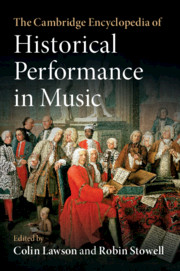 The Cambridge Encyclopedia of Historical Performance in Music. Eds. Colin Lawson and Robin Stowell. Cambridge: Cambridge University Press, 2021. 739pp. ISBN:9781107518476. $41.99.
The Cambridge Encyclopedia of Historical Performance in Music. Eds. Colin Lawson and Robin Stowell. Cambridge: Cambridge University Press, 2021. 739pp. ISBN:9781107518476. $41.99.
The editors of this volume state in the preface that their intention is to provide “a useful and effective starting point for the diverse readership the volume has the potential to attract” (xx). Indeed, this book functions as an important source of information on historical performance practice for performers, teachers, students, scholars, and audiences. Fortunately, this new paperback edition makes the encyclopedia more widely accessible than the original, hardcover edition, which was published in 2018 at a cost of $195 and was a 2019 recipient of the C. B. Oldman Prize from the International Association of Music Libraries. The volume covers a broad range of topics, including issues of style, technique, and practice (“Notes Inégales,” “Temperament,” “Tactus,” “Manuscript,” “Metronome,” “Tablature,” etc.); the history and development of musical instruments (such as “Theorbo” and “Lute”); as well as performers, composers, editors, theorists, and other scholars of historical performance. Contributors to the volume include 112 accomplished performers and scholars whose work represents the latest research in the field.
From my perspective as a guitarist and lutenist, I have a number of specific observations to make regarding particular entries related to my areas of expertise. For example, there are aspects of the entry “Guitar,” by James Westbrook, with which I take issue. Writing of campanellas (an over-ringing technique commonly found on the Baroque guitar that allows notes to overlap with one another), Westbrook states, “It is often impossible to reproduce this effect on a modern classical guitar” (274). This is simply not true. One can reproduce campanellas on the modern guitar, but it is more common to do so on the Baroque guitar. On a modern guitar, it is preferable to play scales one note at a time on the guitar without over-ringing. Later in the entry, Westbrook states, “[Francisco] Tarrega is also known for a special effect utilized in his Recuerdos de la Alhambra, achieved through the creation of a quasi-mandolin ‘sustaining’ of the upper part by alternating the ring, middle and index fingers (a, m, i) against an arpeggiation played by the thumb” (276). This is not very clear; this technique is better described as “tremolo.” Futhermore, the pattern of this tremolo technique is commonly known as “p, a, m, i” (short for the Spanish pulgar (thumb), anular (ring finger), medio (middle finger), indice (index finger). “P, a, m, i” should be written out in full in order to avoid confusion with the flamenco tremolo technique “p, i, a, m, I,” which has one extra note plucked by the index finger.
Jakob Lindberg’s entry, “Lute,” is well-written overall, with good coverage of lute history, tablature reading, tuning, and so forth, but could be expanded slightly to address certain additional considerations. The lute functioned not only as a solo instrument, but often as accompaniment to voice and other instrument, something that is not emphasized in this entry. There should be some reference to the lute’s role as a continuo instrument, something that is not mentioned at all. There are also some typographical insistencies, particularly the appearance of “arch lute” as two words (376), which is incorrect and does not match the appearance of “archlute” earlier in the volume (26).
Lindberg also contributed the entry “Theorbo,” which is likewise well-written, but has similar issues. In particular, it does not sufficiently explore the theorbo’s key role as a continuo instrument.
Ross Duffin contributed the entry on Paul O’Dette. Duffin indicates that O’Dette has “won numerous awards” (448). It should be specified that he in fact won two Grammys, given the significance of this accomplishment.
The volume’s back matter and supplemental materials are helpful, but could be expanded. At the end of the book is a detailed index listing all of the entries in alphabetical order, aiding readers in finding content on interrelated topics. A select further reading list is provided at the end of each entry wherever the editors have deemed it useful. A helpful addition would be an index of the entries by author, so that the reader may easily locate all entries by a given contributor.
Overall, this book provides a wide range of entries covering many terms and concepts in a concise manner. Entries are written in simple and accessible language and effectively distill essential information. The book is thus a handy reference, but not necessarily a solution for a reader looking to understand a concept in more depth. For such a reader, however, the suggestions for further reading provided in the volume will be helpful.


